
| « A Morning in Iceland | Rotterdam » |
The great oil painters of the past generally fall into two categories - those it would be great to have a beer with (Rubens, Manet, Breughel, Bosch) and those best left to drink alone (Gauguin, Caravaggio, Van Gogh, Degas).
This has nothing to do with talent, and everything to do with a certain basic affability. For example, Vincent Van Gogh is a personal hero of mine, and probably the best colorist there has ever been. But it's hard to deny that he was a touch on the volatile side, somewhat creepy around the ladies (viz. stalker-like infatuation with first cousin), and prone to psychotic episodes. Not someone you want to see lifting a heavy tankard across from you in a confined space.
Similarly, just because Degas was a reactionary, Caravaggio was a thug, and Gauguin liked to knock up thirteen-year-old girls doesn't mean the boys were bad painters (Gauguin is a bad painter on the merits). But it does put a damper on fantasies of the "if you could invite any twelve people to dinner" stripe, at least for people like me.
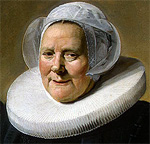
By far the top choice for Old Master drinking buddies has to be Frans Hals, the 17th century Dutch portraitist. In an era of dour self-importance, Hals painted people who looked real and alive - happy, even - and managed to infuse the most formal group portraits with a vital spark. His style is almost casual, but there is no portraitist who can touch him.
It's fun to watch people walk through a museum room with a Frans Hals painting - they inevitably get hooked by it in passing, and stop in a little double take. Hals painted in a kind of shorthand - quick zigzags and precisely jotted lines that come together to create a sense of total realism. Three hundred years before Impressionism, he had the moves down cold.
Hals was born in Antwerp, but lived nearly all of his life in the city of Haarlem, a bustling economic center in his day. The railroad has made Haarlem practically a satellite of Amsterdam, just fifteen minutes' train ride away, but the city has managed to keep its own identity. Modern-day Haarlem has a population of just 150,000 (i.e., half of Iceland), but it was an extremely swinging place in the 1650's, and the fun hasn't died down yet.
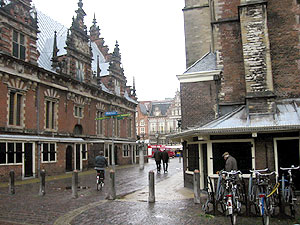
The town center is stately and historic, just like you'd expect, but after nightfall the many small streets all come to life, with nice pubs and cafes, and the beautiful people all come out to dine in boutique restaurants, relaxing as they enjoy The Slowest Service In Holland. There is even the obligatory red-light district, squeezed in behind the old Fish Hall off the main market square.
For me, visiting Haarlem was like paying a visit to Disney World. Somehow this little corner of Europe had sparked up and, over a fifty-year stretch, brought forward a double handful of the best painters of all time. All I could do was drink plenty of the local water, and gape, and hope some of the magic might rub off on me.
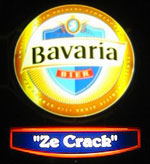
I stayed at a warrenlike hotel called the Carillon (Carillon is Dutch for 'mildew'), whose Chinese owners were able to switch from English to Dutch to Mandarin with an intimidating fluency. For all the dankness, the hotel was hospitable and cozy, and it occurred to me that Haarlem might be a lovely place to bed down when visiting Amsterdam in a more touristy time of year.
Tourbooks will tell you that Frans Hals died broke in a Haarlem poorhouse, and it was a huge relief to find out that the tourbooks are wrong. Like with many of the great 17th century Dutch painters, not a lot is certain about Hals' life. We know that he hit hard times at some point in his later career, because his possessions were auctioned off to pay his debts. And he certainly did spend the last twenty years of his life in the Haarlem Almshouse, which is the same building that now serves as the Franshalsmuseum. But the almshouse was more of an upscale retirement home than a homeless shelter, and it's clear from Hals' paintings that he continued to hang out with and get commissions from some upscale locals. He even got a pension from the city towards the end of his long life - certainly a mark of recognition and appreciation.
The almshouse residents did collect alms once a week, walking around the town square, but the process was strictly pro-forma. The museum posts some of the other amusing house rules:
"In order to be considered for a place in the home, men had to be at least 60 years old, officially resident in Haarlem, single and have led an honest life. They also had to bring their own household articles with them, such as a good bed, a chair with a cushion, a tin chamber-pot, three blankets, six good shirts and six night-caps."
"They were not allowed to take more than one jug of beer to their rooms."
So think sophomore-year housing, with night-caps and old people.
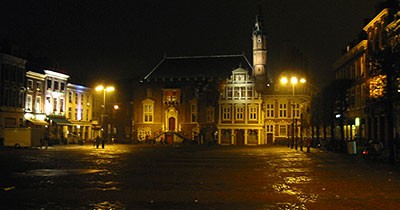
Haarlem in the 1650's was a rich town, third in size after Amsterdam and Leiden. The Franshalsmuseum has a spectacular antechamber exhibit that details the economic and political context of the time without being boring about it. The curators have selected several period landscapes and cityscapes, and blown them up massively so a magnified painting completely covers each wall. This lets them place explanatory text next to points of interest, conveying a lot of information about the town, and as a side effect reminding viewers of the fantastic level of craftsmanship that went into oil paintings back then. You can see women bleaching linen in a stream, brewers brewing beer, ships entering harbor, local magnates and celebrities standing in front of their stately homes - an almost photographic panorama of life in the 1600's.
The old quarter of Haarlem is very well-preserved, so that you walk out of the Franshalsmuseum and find yourself in the same streetscapes you just saw on canvas, except with bicycles added in and fewer livestock.
According to the museum statistics, there were some 142 painters active in Holland between 1605-1635, and together they produced over a hundred thousand paintings. The fact that many of those paintings were masterpieces, even though the total urban population didn't exceed a half million, is one of those enduring mysteries of culture. Somehow the time was so right for art that this small corner of the world outdid all of England and Germany, before or since, before sinking back into obscurity.
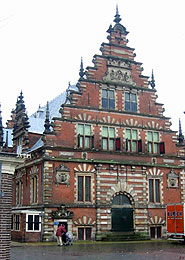
| « A Morning in Iceland | Rotterdam » |
brevity is for the weak
Greatest Hits
The Alameda-Weehawken Burrito TunnelThe story of America's most awesome infrastructure project.
Argentina on Two Steaks A Day
Eating the happiest cows in the world
Scott and Scurvy
Why did 19th century explorers forget the simple cure for scurvy?
No Evidence of Disease
A cancer story with an unfortunate complication.
Controlled Tango Into Terrain
Trying to learn how to dance in Argentina
Dabblers and Blowhards
Calling out Paul Graham for a silly essay about painting
Attacked By Thugs
Warsaw police hijinks
Dating Without Kundera
Practical alternatives to the Slavic Dave Matthews
A Rocket To Nowhere
A Space Shuttle rant
Best Practices For Time Travelers
The story of John Titor, visitor from the future
100 Years Of Turbulence
The Wright Brothers and the harmful effects of patent law
Every Damn Thing
Your Host
Maciej Cegłowski
maciej @ ceglowski.com
Threat
Please ask permission before reprinting full-text posts or I will crush you.